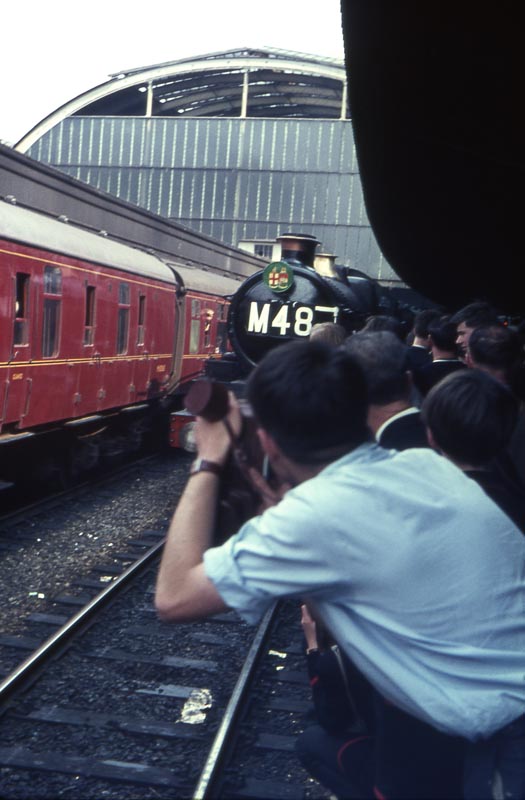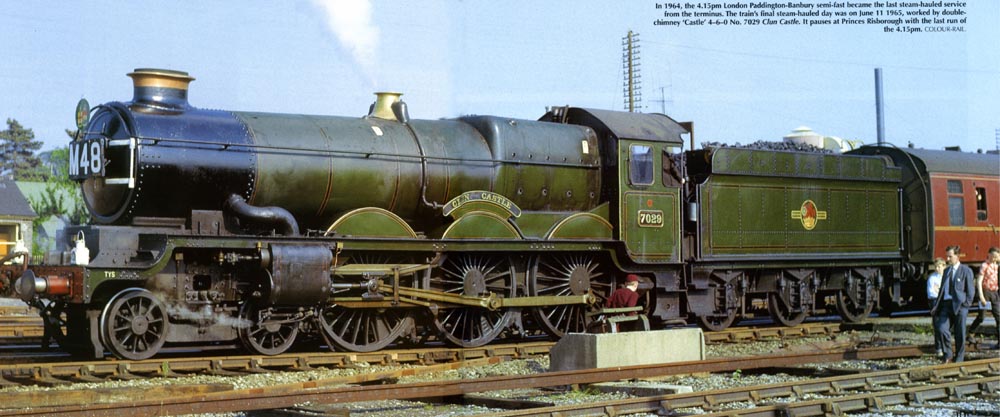While travelling in Spain in the
Summer of 2007 I met John Bennett and we quickly began to reminisce
about the last days of steam on the Wesern Region of British
Railways. John sent me the above picture with
the following comments:
The last 4.15 from Paddington, 11th
June 1965. At Princes Risborough
The 4.15pm to
Banbury was the last regular steam-hauled departure from Paddington,
and this
is a photo of the last one. I was on it.
June
11th
is my Birthday and my father had given me a new 35mm camera. This is
one of the
first photos I ever took with it. Previously I had had a camera which
did 2¼”
square
negs. This is one of the first rectangular photos I ever took.
However, when I
took the shot I got a telegraph pole sticking out of the top of the
smokebox,
to the left of the chimney. My brother has just given me a computer
(which he
had assembled and programmed). It came with two programmes for altering
(“improving”) photographs and I have at last managed to remove the
telegraph
pole. I´ve wanted to do this for more than 40 years...
I
(Colin Churcher) rode Clun Castle on this train a week or so before
this and this
is what I wrote:
Although much
of the office training
as a British Railways Management Trainee was some way removed from the
real
railway, I did manage to do some interesting things. Tuesday, June 1,
1965 was
one of those days. I slipped out from the Regional Accountants Office
and
entered the washroom to emerge, like Clarke Kent
in a disguise, only I was
dressed in engineman's blue overalls. Many of the people I passed in
those
august halls turned their noses up at my humble self daring to walk
where
General Managers had walked but I had a date with Clun Castle
and the 1615 Paddington.
The
1615 Paddington to Banbury was the
last regularly scheduled steam passenger train out of Paddington and it
was due
to be replaced with a diesel at the change of timetable some ten days
hence. I
had obtained a footplate pass from my friends in the Divisional
Office and
elbowed my way past the many admirers to present it to Driver Cott
and Fireman
Heath of Banbury. Even the Assistant General Manager - Staff was
watching. I
reported directly to him and he knew that I should have been in the
Accountant's Office, so I kept well in the shadows by the front
spectacle plate
until we left the station. The empty coaches were late arriving at the
platform
behind the Western diesel hydraulic and we left a couple of minutes
late. With
a short blast of the whistle, we departed smoothly without any
slipping. Waving
to the crews on other trains waiting to depart it was a sobering
thought that
the soft exhaust beats from Clun Castle
were the first and
last steam engine sounds that would be heard under Brunel’s roof that
day. We
went out Main Line waving to more railwaymen at Ranelagh Bridge
and there were more watching us from the Paddington Carriage Servicing
Yard. In
fact, it was as if the railway had come to a momentary halt so that
everybody
could watch us go past.

The scene
at Paddington on 11 June 1965. This was about as close as I was
able to get to the locomotive.
The back of the head of the schoolboy in the blazer is John
Bennett who writes "People who ought to know (or ought to remember) all
agree that it IS the back of my head on the right of your photo of the
last 4.15 at Paddington".
Firing
was easy and the
steam and water were comfortably maintained. The driver's side injector
had
been modified to give a slower rate of delivery and this was sufficient
to
maintain the water level. We were on time at Gerrard's Cross, our first
stop.
Another memory returned with the very strong smell from hot brake
blocks - a
smell that cannot be experienced with the diesels. There weren't very
many
people at Gerrard's Cross and we were very quickly away to Beaconsfield.
Although there were few people
on the train, there were many people of all ages watching us go past. I
must
have been recorded in still and movie many times that day. We soon
reached Beaconsfield,
again
marked by the lack of passengers, and I began to earn my keep by taking
over
the shovel. I fired all the way to Bicester which was very easy not
only
because of the light load but also because of the easy timing and
lengthy
station stops. The GWR shovel is big and will take an enormous amount
of coal.
This means that a big swing is required to get a shovelful right to the
front
of the firebed. A certain amount will shake down from the back but not
enough
to keep the front adequately fed. I bounced the shovel off the back
part of the
fire but I always found that the most difficult part was to avoid a
build up in
the middle half way in where the back starts to drop steeply down to
the front.
A build up here will quickly stop coal from getting to the front and
will build
up even quicker thus starving the front. If this happens the only thing
to do
is to get out the pricker and smooth out the bump.

In 1964, the 4.15 pm London
Paddington-Banbury semi-fast became the last steam-hauled service
from the termnus. the train's final steam-hauled day was on June
11 1965, worked by double chimney 'Castle' 4-6-0 No. 7029 Clun
castle. It pauses at Princes Risborough with the last run of the
4.15 pm. Colour Rail. Steam World August 2007.
We
had a five minute
station stop at High Wycombe and
17½ at
Princes Risborough where we waited for the Birmingham Pullman to pass
in the
through road. At Bicester we drew forward into the siding, to allow the
1710
Paddington to stop in the platform and then drew back to continue on
the last
leg to Banbury. A railway enthusiast came up to us to say that a friend
of his
was just outside the station with a camera and would the driver please
give it
the lot. We left Bicester in a hurry. Clun slipped a bit, but soon
found her
feet and must have presented a good action subject for the photographer.
There
is a climb of 1 in
200 up through Ardley and this was the only time that we were in
trouble for
steam. The reason for this was obvious. Clun had become cold during the
long
stand at Bicester. The fire was alright and the bar soon helped to put
things
right. As it turned out, this helped to create a most unusual trip
through the
tunnel before Aynho. The firehole doors were almost closed and there
was only a
narrow shaft of light thrown back on to the tender. The tunnel,
although less
than a mile long, is curved so that one cannot see the end. It was
pitch dark
and I couldn't even see the smoke following the contours of the boiler
and
wallowing over the top of the tender.
There
was a brief pause at
King's Sutton, then unstaffed, and the evening sun that came out to
help our
way into Banbury, was the sort of sunset that would bring a lump to
one's
throat. That day there was a particularly large lump in my throat. I
was saying
goodbye to some dear friends - first Gladiator, then Tretower Castle,
Swindon, Sir
Edward Elgar and
finally Clun
Castle. A
short 15 mph permanent way
slowing, a brief signal check and we ran into the relief platform at
Banbury.
The crew were in a hurry to sign off duty, so we quickly uncoupled and
ran
forward to the starter. Two class 9 2-10-0s on their way to take up an
iron ore
working and we were given the road right through the down main to the
shed
where Clun was berthed on the coal stage road. Without looking back the
crew
quickly walked to the shed office to go home but I lingered around. Clun Castle
was looking good with her brightwork well polished. Banbury had added a
nice
touch. The number 7029 was painted on the right hand front buffer beam
as a
reminder of former GWR standard practice. I just stood and looked at
her
simmering quietly in the evening sunshine. The trip had been an easy
one that
hadn't really extended either engine or crew but it was one of the last
trips
in regular service. To the men there was nothing exceptional about this
run -
it was just another day's work - and they were looking forward to the
diesel relacement. This cannot be replaced now that the steam
engine is a rare spectacle. To-day's steam specials with their holiday
atmosphere cannot replace the everyday commonplace type of trip that
this was.
Because it was commonplace this trip meant much more to me as my
feelings were
not diverted by the spectacle itself.
I
finally tore myself away
from Clun and, with moist eyes, made my way sadly back to the station
to catch
a diesel multiple unit home. That was the last time that I rode a
British steam
locomotive.
|



